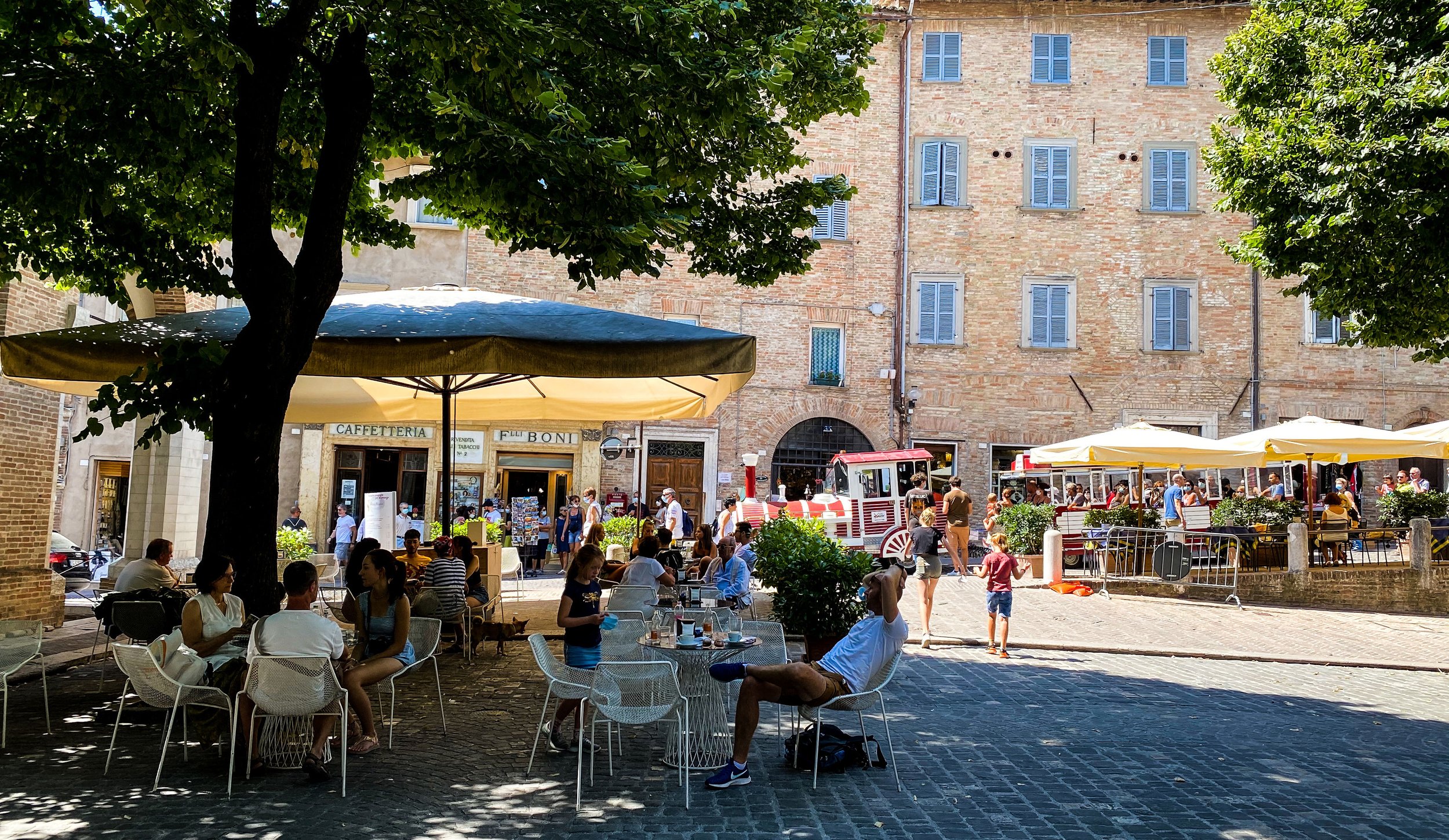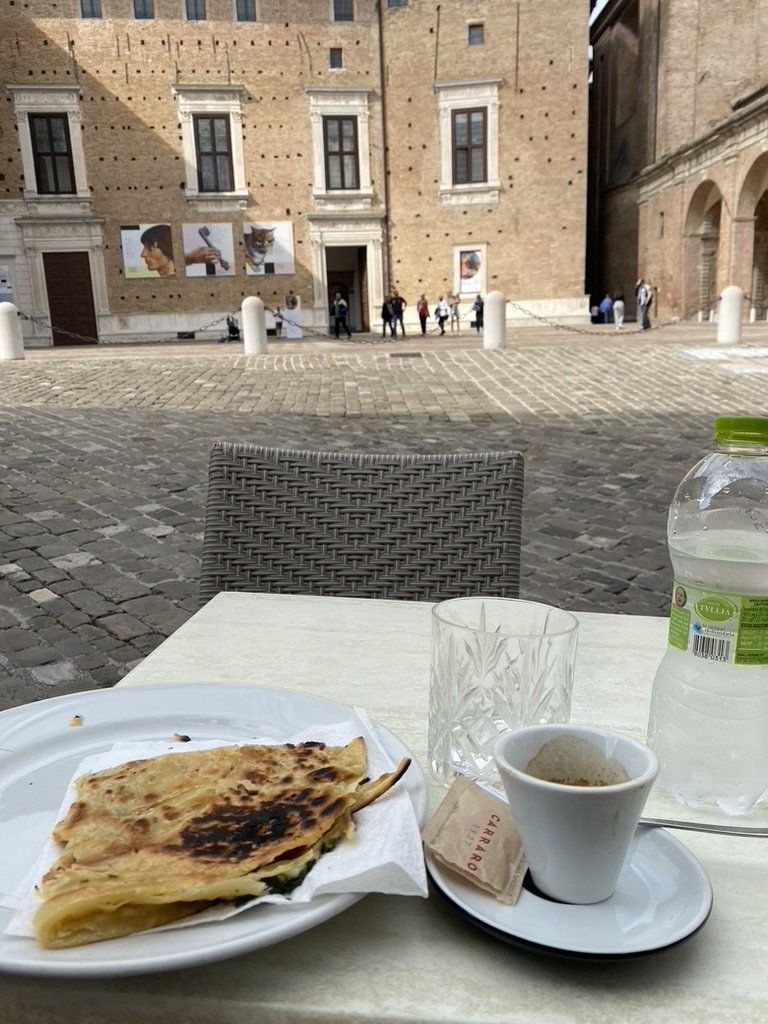Steeped in Art, History & Stairs
Between the Metauro and the Foglia valley, 1,650 feet above sea level, lies the charming walled hilltop city of Urbino. Known as the hometown of artist Raphael Sanzio and architect Donato Bramante, it owes much of its fame to the Duke Federico lll of Montefeltro. He was a mercenary general who turned Urbino into an important Renaissance centre, attracting artists and scholars such as: Piero della Francesca, Paolo Uccello and Raphael’s father, Giovanni Santi.
View of Urbino from the Albornoz Fortress
Since there isn’t a train station in town, I travelled to Urbino by bus from Fossombrone. Thankfully, upon arrival at the bus station (ground level), there are two separate elevators that take you to the 10th floor and onto Corso Garibaldi. From there, it is a short, level walk to Piazza della Repubblica. Once you pass through one of the four city’s gates, I immediately marvelled at how the city is just dripping in Renaissance symmetry. Awestruck, I made my way towards Palazzo Ducale, happily taking in the view and grateful to be wearing comfortable walking shoes to navigate those steep albeit short climbs.
Urbino is a Renaissance brick city with wider alleys than a Medieval town and steep climbs that give it a distinct feel. It also hosts an important 500-year-old university.
With just a few hours to explore this remote town of 24,000 inhabitants (comprised largely of university students), I had a quick piadina and headed off to Palazzo Ducale.
PALAZZO DUCALE
Piazza Rinascimento
Since I only had a few hours in Urbino, I asked the founder of the popular Wonderful Marche blog, Juliana De Brito, how best to capture the true magic of this UNESCO-recognized historic centre during a brief stay. “The Palazzo Ducale is arguably the heart of Urbino’s historical narrative. Not just an architectural marvel, it’s a gateway into the past, housing the Galleria Nazionale delle Marche, where visitors can immerse themselves in masterpieces by Piero della Francesca and Raphael. The Palazzo’s intricate art, devotion and history highlight the Renaissance’s emphasis on the unity of artistic expression and cultural significance.”
The arcaded courtyard at Palazzo Ducale, designed by Luciano Laurana, represents the aesthetic ideals of the Renaissance.
BIRTH HOUSE OF RAFFAELLO SANZIO
Via Raffaello 57
It’s described as a modest yet profoundly historical building.
“It allows visitors to connect personally with one of the Renaissance’s greatest minds. It’s not just about seeing where Raphael spent his early years; it’s about understanding the environment that shaped his vision and creativity,” adds De Brito.
Birthplace of Raffaello Sanzio is now a museum. In 1873 an accademia was formed here in his birth home, amassing the collection of artwork and furnishings you see today. Photo by Silvana Longo
Not far from Casa Santi is the Albornoz Fortress, built in the second half of the 14th century on the highest point of the city. “The fortress stands as a reminder of Urbino’s strategic importance and its ability to withstand the test of time, offering breathtaking views that captivate the imagination,” says De Brito.
Other highlights include the Oratory of the Santissimo Crocifisso della Grotta hidden beneath the Cathedral of Urbino. It consists of four chapels built between the 16th and 17th centuries. Inside the Chapel of the Resurrection is a marble Pietà sculpted by Giovanni Bandini in 1597.
Oratorio San Giovanni Battista; Affresco by Lorenzo e Jacopo Salimberi
Built on the highest point of Monte di S. Sergio in Urbino, the Albornoz Fortress is named after Cardinal Albornoz
Any guidebook will give you the highlights, however, it is beyond these well-trodden paths where Urbino’s true magic lies. “The city’s narrow, winding streets and hidden courtyards are ripe for exploration. Each corner turned reveals a piece of history, a local artisan shop, or a quaint café that invites visitors to slow down and soak in the atmosphere,” advises De Brito. The intimate connection with Urbino’s daily life is something that makes this destination even more special.
LOCAL MUST-TRY FOOD
Casciotta PDO of Urbino: Delicate and aromatic cheese made from a blend of sheep’s and cow’s milk, giving it a unique flavour profile.
Prosciutto PDO of Carpegna: The blend of lard and spices lend a delicate scent, while the Cervian sea salt infuses the pork with a lightly sweet flavour.
Puffed Crescia (Crescia sfogliata): A distant relative of the piadina romagnola with a history dating back to the dukes.
Passatelli: Fresh pasta mixed with parmesan and breadcrumbs often served in broth, or a dry version topped with truffle.
ALL PHOTOS OF URBINO COURTESY OF THE COMUNE DI URBINO









